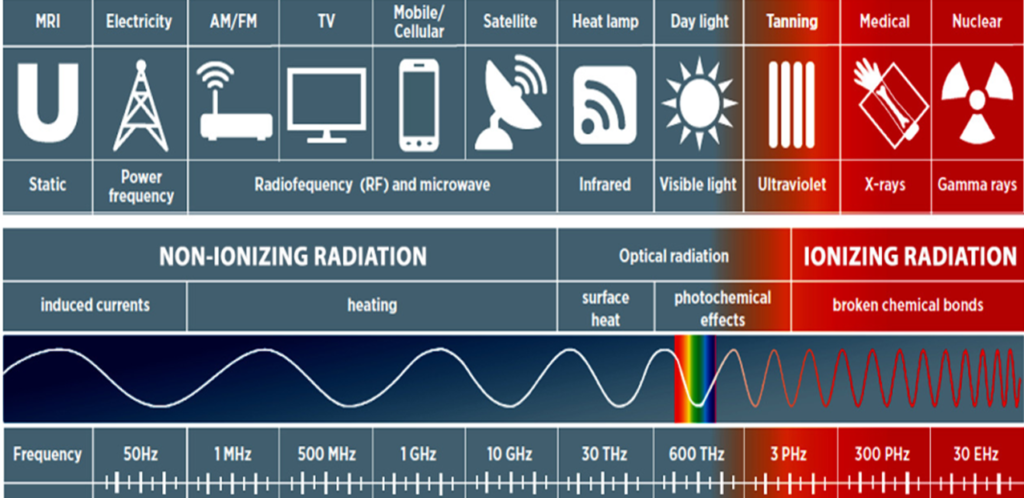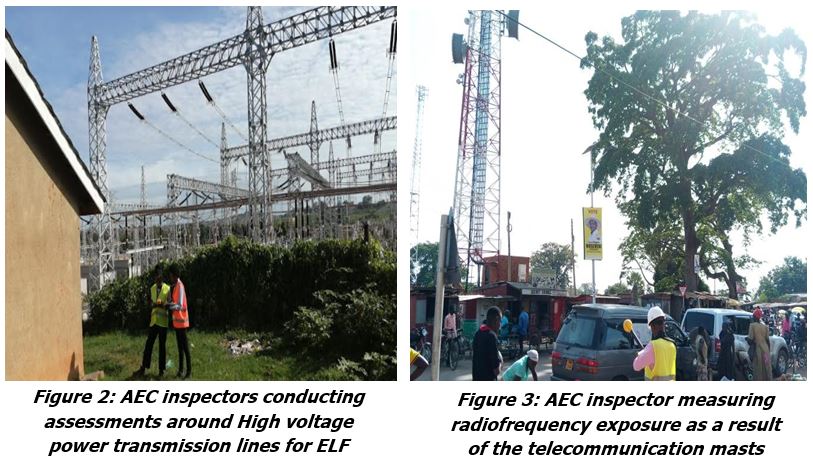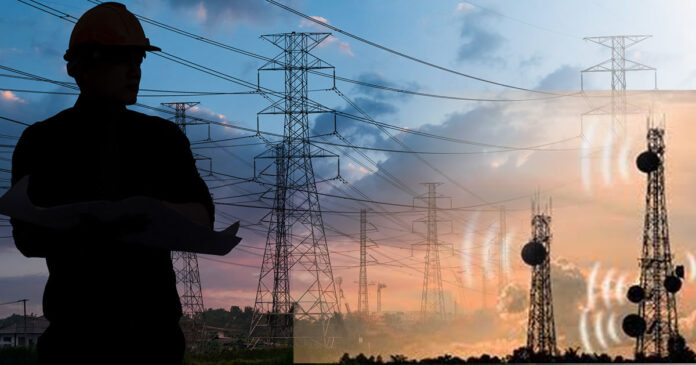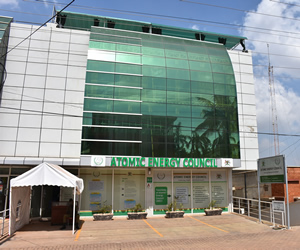Introduction
“Non-ionizing radiation” means all forms of radiation and fields of the electromagnetic spectrum that do not normally have sufficient energy to produce ionization in matter; characterized by energy per photon less than about 12 milli-electron-Volt, which is equivalent to wavelength greater than 1mm, or frequencies lower than 3 x 1015 Hertz (It is weaker than ionizing radiation).
Applications of non-ionizing radiation
There are numerous sources of non-ionizing radiation around us that may be artificial or natural sources. The artificial sources include telecommunication towers, high voltage power transmission lines, Magnetic Resonance Imaging (MRI) machines, radars, microwave ovens, metal detectors, welding torches, television remote controls among others while the natural sources include the sun, fire, celestial bodies, the earth and some plants and animals. These sources emit different types of radiation as indicated in figure 1 and thus some may warrant regulatory control like the base stations, MRI machines, high voltage power lines. Those that may not warrant regulatory control include the sun and fire. Welding torches, metal detectors, microwave ovens, television remote controls require that the devices meet the standards. The applications have both social and economic benefits like the use of MRI machines, base station and high voltage power lines utilized in the medical, telecommunication and electricity industries respectively.

Health and Biological Effects
Whereas non-ionizing radiation plays an important role in our lives, prolonged exposure to high levels of the radiations can be detrimental to human health and the environment. The radiation interacts with matter at the atomic level, at which they deposit the energy they carry into the atoms. On a large scale, the energy deposited translates into cellular and tissue heating in living organisms that may escalate into a wide range of possible health effects for intense exposures. A number of epidemiological studies have been conducted globally and there is an indication that a number of probable health effects that may occur as a result of excessive exposure to radiation from sources of non-ionizing radiation. Although inconclusive, some studies attribute some forms of cancers (such as childhood leukemia), headaches, nerve stimulation, fatigue, insomnia, sterility, and infertility among many others to being exposed to non-ionizing radiation.
Measurements have shown that environmental levels of non-ionizing radiation typically encountered by the general public are below levels necessary to produce significant or easily noticeable biological effects. However, there may be situations, particularly workplace environments near high-powered sources, where recommended limits for safe exposure of human beings to non-ionizing radiation could be exceeded. In such cases, safety measures or actions may be necessary to ensure the protection of the people. Non-ionizing radiation may result in both biological and health effects as a result of the prolonged exposure to the radiation as indicated in below.
Some of the biological effects of non-ionizing radiation include;
- Short-term/temporary conditions induced by exposure to high radiation intensities (even for a short time).
- Result from tissue heating by radiation energy deposition in cells
- Vulnerable organs include brain, eyes, heart, and digestive organs – they are too thick for effective heat dissipation
- Headache, dizziness, insomnia, nausea, fatigue, digestive disorder, cardiac stress, among others
The health effects of non-ionizing radiation include;
- Detectable impairment on the health of an individual or offspring, requiring a medical intervention to reverse.
- Blood leukemia, glioma (cancer of nerve and brain cells), Alzheimer’s disease (memory impairment), eye cataracts, and sterility (damaged sperms)
- Vulnerable organs: brain, nerves, eyes, blood, bone marrow, testes and skin: – sensitive and prone to electrochemical and photochemical reactions
NB: NIR health effects are not confirmed, research studies are currently still ongoing.
Regulatory Infrastructure for Non-Ionizing Radiation
The Uganda Communications Commission regulates the Communications sector, which includes Telecommunications, Broadcasting, radio communication, postal communications, data communications and infrastructure. The Uganda National Bureau of Standards regulates standards of equipment including those that generate non-ionizing radiation. The Atomic Energy Council is responsible for protecting individuals, society and the environment from radiation exposure from the applications of non-ionizing radiation.
Role of AEC in ensuring Radiation Protection and Safety from Non Ionizing Radiation
Section 2(3) of the Atomic Energy Act No.24 of 2008 and the Atomic Energy (Application of provisions of the Atomic Energy, 2008 to sources of Electromagnetic Radiation) Order, 2023, mandates Council to regulate the sources of electromagnetic radiation other than X-rays and gamma rays.
In this regard, the Council is conducting a nationwide assessment of radiofrequency (RF) and electromagnetic field exposure levels. The assessments are currently being carried out in public places. Figure 2 and 3 show AEC inspectors conducting assessments at High Voltage lines and telecommunication masts respectively. The measurements from the assessment exercise indicate that the radiation levels are below the maximum recommended safety guidelines at all the surveyed locations so far.

What can be done to ensure Radiation Protection from Non-Ionizing Radiation
- The public should maintain the safe distances from the sources of non-ionizing radiation.
- The installers/commissioners of telecommunication masts should comply with the national standards.
- The wayleaves for the power transmission lines should be respected.
- Periodic assessments should be conducted to determine the extent of radiation exposure from the sources of non-ionizing radiation.
Conclusion
Non-ionizing radiation sources AEC has established a regulatory framework to:
- Allay public (and political) fears and concerns on the safety of exposure to environmentally prevalent levels of NIR
- Ensure that operators and sources do not emit radiation levels that are beyond the regulatory/safe limits.





